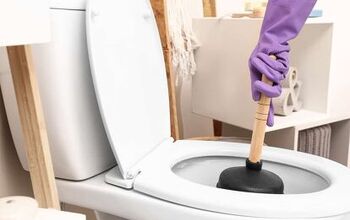How To Fix A Sagging Mattress With Plywood (Quickly & Easily!)

Most people out there won’t have the money to spend on one of those luxury mattresses that “don’t sag,” which is why it’s normal to start feeling a little dip in your bed after a year or two of use. Sagging mattresses aren’t fun, though. They can harm your back and make it difficult to sleep. Thankfully, there’s a really nice, quick fix you can accomplish using something as simple as plywood…
To fix a sagging mattress, remove the mattress from your bed frame and cut a piece of plywood that can fit directly on the frame. Place the plywood on the bed frame’s slats, then place your mattress on top of the plywood. The wood will give you enough support to reduce the amount of sagging you experience.
If you’ve been struggling with getting a good night’s sleep, then you need to start working on a fix as soon as possible. A bad mattress can easily lead to sleepless nights, sore backs, and other similar issues. Following the steps in this guide can help you get a quick fix until you can get a new mattress.
Do You Need Handyman Services?
Get free, zero-commitment quotes from pro contractors near you.

How Do You Use Plywood To Fix Your Sagging Mattress?
The easiest way to reduce sagging in your bed is to place a large sheet of plywood over your bed’s slats as a way to improve support. With more support comes less sagging. That much is obvious. But, is this really a fix? Well, no…
Technically, the plywood doesn’t fix the mattress. Your mattress will probably still sag a little, even with the plywood support. Mattresses can’t be fixed. They age, and that’s why you eventually have to replace your mattress. It’s a natural part of your mattress’s life cycle and it’s not exactly avoidable.
How Thick Does Your Plywood Have To Be?
A common mistake people make with the plywood fix is assuming that any sheet of plywood would be alright. This isn’t true. Thin plywood will not be enough to handle the weight of a person laying down on the mattress, nor will it be enough to deal with regular movement. To keep things safe, you need plywood to be at least 3/4 inch thick.
While 3/4 inch thick will be enough for people who are young and petite. If you have more than one person sleeping in the bed, you should aim to get a piece of plywood that’s at least one inch thick.
Why Do People Prefer Using This Quick Fix?
The biggest reason why people tend to prefer using this fix is pretty obvious: no one wants to sleep on a saggy mattress. It’s bad for your back. Unfortunately, mattresses cost an arm and a leg. Most of us can’t just randomly run out to the store and get another one. That’s where adding plywood underneath your mattress can act as a buffer.
Using the plywood fix is a cost-effective way to reduce the sagging, all while giving you enough time to save up for a new mattress. Moreover, this fix is about as easy as it gets. Even if you don’t have any kind of experience doing home improvement things, you can find a store to cut some plywood for you and fir up your mattress in a pinch.
Should You Sand Down Your Plywood?
Honestly, it’s not necessary but it can be a good idea. Sanding down your plywood can help prevent your mattress from snagging on sharp wood. If you do this, you don’t need to spend too much time on it. Just a little bit of sanding can do a ton of good for your mattress’s safety.
How Good Of An Idea Is This?
It’s important to remember that adding plywood underneath your mattress is a measure to temporarily extend the life of your mattress, not be a part of your mattress for life. If you just need a little extra firmness while you save up for a new mattress, this is a great idea. If you’re thinking that this will solve all your mattress problems, it’ll fall short of your expectations.
Should You Add Plywood Under Your Mattress As A Preventative Measure?
A lot of people tend to see this “plywood” fix as a preventative measure that should be done as soon as you buy a mattress. This is actually a pretty bad move if your mattress isn’t actually sagging yet.
Let me emphasize this: plywood is not something you want to add to the top of your bed slats immediately after you bought your new mattress. In fact, it’s actually pretty bad for your mattress over the long term. Here’s why:
- Plywood does not allow your mattress to breathe the way it should. This means that you might end up trapping excess moisture in your mattress, which could lead to mold growth, bacterial growth, as well as other issues.
- Placing your mattress on plywood will shorten its lifespan. With movement on your bed at every turn, you can expect the fibers to catch and snag on the plywood. After all, plywood is not exactly the smoothest material on the planet. This will cause your mattress to have little tears, which can decrease the overall well-being of your mattress.
- If you currently have your mattress in a case due to bed bug-related problems, it’s important to realize that the plywood can rip the case. It only takes one splinter to poke a hole in a bed bug mattress case. Considering how much a bed bug exterminator costs, it’s best to err on the side of caution if you have this pest problem and want to fix the mattress.
- In some rare cases, it can also make it easier for bed bugs to hide. If you are currently struggling with bed bugs or similar pests, you should not make it easy for them to hide. Having plywood on your bed gives them more potential nooks and crannies where they can corner themselves.
What Is The Best Way To Fix A Sagging Mattress?
The plywood trick is good, but if you don’t feel like springing for a piece of plywood, you have other options. You can flip the mattress over, prop a pillow in the sagging area, or just use a mattress topper—just to name a few other fixes. With that said, it’s still a good idea to take a look at your mattress and bed’s overall shape if you want to choose the best possible option.
When you’re trying to figure out the cause of the sagging, it’s important to look at your bed frame and slats. If your frame looks damaged, fix it before you get a new mattress. This will ensure that you get the best possible lifespan for your new frame, and also prevent further damage to your current mattress.
Do You Need Handyman Services?
Get free, zero-commitment quotes from pro contractors near you.

Related Questions
How long should you expect a mattress to last before it sags?
Though sagging mattresses are a common issue, you shouldn’t expect it to happen nearly immediately. In fact, recent technology made the lifespan of mattresses longer than ever. A typical mattress will last between 7 to 10 years without any signs of sagging.Futon mattresses are a little different, though. A futon mattress will show signs of sagging soon after it has been purchased, simply because they are regularly folded in half.
Are there any types of mattresses that don’t sag?
If you want to avoid sagging at all costs, the best choice for your mattress purchase would be a latex foam mattress or a memory foam mattress. Most foam mattresses have reduced sagging incidents and can last as long as 15 years without any sign of sagging.
What kinds of mattresses are the most likely to sag?
All mattresses will eventually need replacement or sagging, and that includes foam mattresses if they’re left for too long. In terms of sagging, the worst types of mattresses tend to be box spring mattresses. Box springs tend to have the shortest lifespans, the highest chance of warping, and are generally the most likely to break due to spring usage.

Ossiana Tepfenhart is an expert writer, focusing on interior design and general home tips. Writing is her life, and it's what she does best. Her interests include art and real estate investments.
More by Ossiana Tepfenhart













![10 Best Electric Pressure Washers – [2022 Reviews & Guide]](https://cdn-fastly.upgradedhome.com/media/2023/07/31/9070600/10-best-electric-pressure-washers-2022-reviews-guide.jpg?size=350x220)













